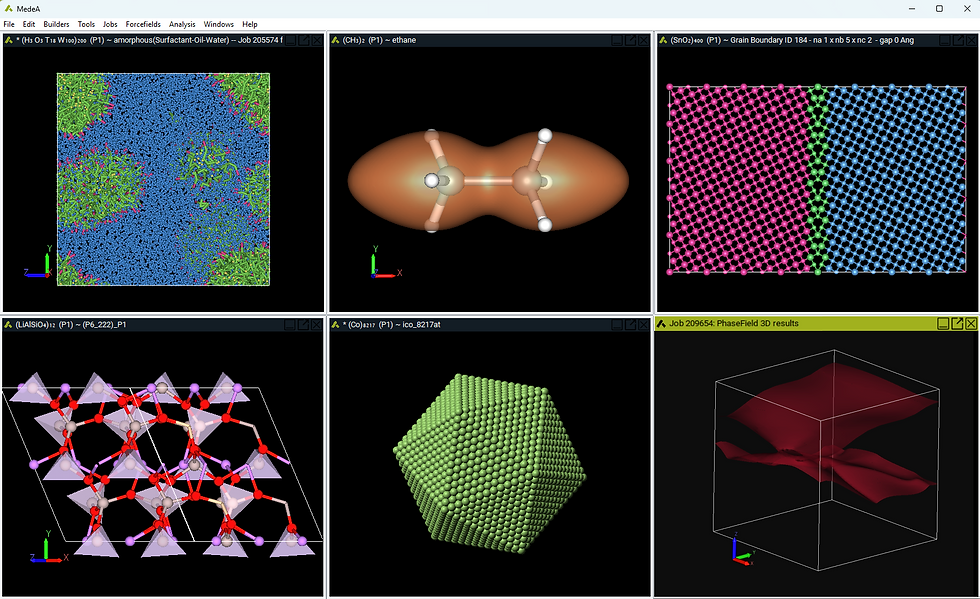MedeA Software Release MedeA 3.5 -- Make Your Work Flow!
- Katherine Hollingsworth
- Jul 13, 2022
- 3 min read
Updated: Jul 14, 2022

Materials Design Announces the Release of MedeA 3.5, 'Make Your Work Flow!'.
Materials Design is delighted to announce a new release of its world-leading materials simulation MedeA Environment. The MedeA 3.5 release features a new Flowchart interface for constructing automated simulation protocols to carry out high-throughput simulations with the desired level of sophistication. Additional enhancements include a fully integrated VASP 6.3 interface with access to a broad range of VASP capabilities, and extensive analysis and infrastructural enhancements.
Dr. Marianna Yiannourakou, Director of Product Management at Materials Design and regular contributor at chemical engineering conferences worldwide, said of the new MedeA release: "It is a real pleasure to see the culmination of this development cycle on general release. We have worked closely with our partners in industry and academia to create this release and target the functionality that truly assists researchers executing the highest quality research and development possible in computational materials science."
MedeA 3.5 provides access to VASP 6.3.1, additional high-throughput simulation capabilities, and includes a new pcff+ H2O model, able to describe accurately the liquid water structural characteristics (radial distribution function), and additional properties such as surface and interfacial tension.
A list of major enhancements is provided below.
Dr. Yiannourakou added, "It has been an absolute privilege to work with extraordinary customers and the Materials Design team to create MedeA 3.5. We are looking forward with great anticipation to seeing the range of ways in which MedeA 3.5 assists users in solving problems using materials simulation methods. As it turns out, we have a good sense of this already, as Materials Design not only develops MedeA, but also employs MedeA continuously in Contract Research projects. This provides a great leading indicator of just how valuable and exciting this round of additions to MedeA are. Our primary goal is to continue developing the MedeA Environment so that it continues to excel in providing accuracy and reliability, and our customers continue to benefit from those capabilities in making their materials modeling work flow."
Description of MedeA 3.5 New Features and Enhancements
MedeA 3.5 June 2022
1. Flowcharts:
A brand-new flowchart interface with improved ease of use for all flowchart stages
Copy/paste functionality for all flowchart stages
Ability to retrieve flowcharts from VASP runs submitted through the (non-flowchart) VASP interface
A new Interfaces stage
2. Builders and Editors:
Structure Lists for calculation automation and information management are now available with the standard MedeA Environment
Structure Lists can be directly created from several flowchart stages, such as:
o VASP
o GIBBS
o Phonon
o MT
o TSS
o LAMMPS Deposition
o UNCLE
Numerous enhancements for large PDB files
o Enhanced connectivity information handling
o Added ability to write large PDB files with hybrid36 extension (for systems containing 100,000 atoms or more)
Added ability to read mmCIF files through OpenBabel
3. Engines:
VASP:
o Full VASP 6.3.1 support via MedeA
o On-the-fly machine-learned forcefields (MLFF):
— Accelerates ab initio molecular dynamics simulations employing machine learning, massively increasing accessible simulation times
— Creates a machine-learned forcefield using ab-initio molecular dynamics trajectories as training set as the simulation proceeds
— Continues machine-learned forcefield optimization running additional molecular dynamics simulations (for other systems)
— Applies machine-learned forcefield without further running ab-initio simulations
o Various improvements and optimizations for non-collinear VASP 6 and 5.4 calculations
o Enhanced of parsing efficiency of large OUTCAR files
o Further support of MetaGGAs (rSCAN, r2SCAN)
o Structure lists (ListOfResults.sli) with final structures and including calculated properties, suitable for forcefield fitting, are now created automatically further enhancing efficiency, analysis, and post-processing options
LAMMPS:
o Updated to the 7Jan22 version
o Added support for new packages:
— PYTHON: both Linux and Windows, on CPUs and GPUs
— SPIN: both Linux and Windows, on CPUs and GPUs
o Improved GPU support:
— Support for Nvidia GPU cards with compute capabilities from 3.5 to 8.6 on both Linux and Windows
— Approximately 40% computation performance improvement for potentials using long-range Coulombic interactions
o Use new rigid pcff+ H2O model employing shake (which is now the default) providing superior rdf, and surface tension for water at ambient conditions
4. Forcefields:
PCFF+:
o Improved water model
5. Property modules:
Phonon:
o Structure list (DisplacedStructures.sli) created, suitable for forcefield fitting
MT:
o Structure list (StrainedStructures.sli) created, suitable for forcefield fitting
TSS:
o Structure list (EnergyProfileStructures.sli) created, suitable for forcefield fitting
#mesoscale #machinelearning #modeling #materialscience #VASP #LAMMPS #GIBBS #softwarerelease #compchem #flowcharts #machinelearning #VASP6



Comments